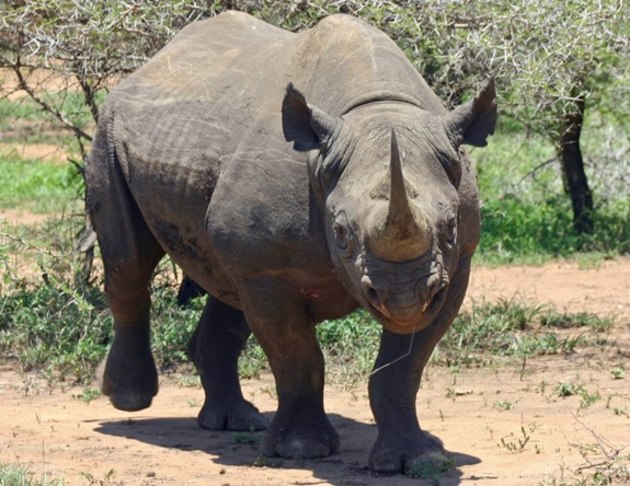Rhinos have been around for millions of years and play a crucial role in their ecosystem as important grazers, consuming large amounts of vegetation which helps shape the African landscape and benefits other animals, keeping a healthy balance within the ecosystem. Rhinos are fascinating creatures that have been around for millions of years and play a crucial role in their ecosystem.
These giant grazers consume large amounts of vegetation, which helps shape the African landscape and benefits other animals within the ecosystem. Despite their importance, rhinos face numerous challenges, including the threat of extinction due to hunting for their horns. We will explore 10+ interesting facts about rhinos and delve into their vital role in the ecosystem.
From their unique adaptations to the reasons behind their significance, these facts will give you a deeper understanding and appreciation for these magnificent creatures. So, let’s dive in and discover the world of rhinos.

Credit: www.wired.co.uk
Interesting Rhino Facts
Rhinos are fascinating creatures that have captured the attention and curiosity of nature enthusiasts worldwide. From their unique physical features to their important role in the ecosystem, there is so much to learn and appreciate about these magnificent animals.
Rhino Horns
One of the most distinctive features of rhinos is their impressive horns. Contrary to popular belief, a rhino’s horn is not made of bone but rather keratin, the same material found in our hair and nails. These horns can grow to incredible lengths, with some rhinos sporting impressive horns that measure up to a meter long. Sadly, the demand for rhino horns in certain cultures has led to widespread poaching, putting these amazing animals in grave danger.
Grey Color
Another interesting fact about rhinos is their unique grey color. This coloration acts as camouflage in their natural habitats, allowing them to blend in with their surroundings. It may be surprising to learn that beneath their thick, rough skin, rhinos actually have a much lighter color, similar to that of an elephant. This grey exterior serves as a protective shield, helping them navigate through dense vegetation without getting too easily noticed by potential predators.
Poor Vision
Despite their massive size, rhinos have relatively poor eyesight. Their eyes are strategically positioned on the sides of their head, providing them with a wide field of vision. However, their visual acuity is not their strong suit. To compensate for this, rhinos rely on their keen sense of smell and exceptional hearing abilities to detect any potential threats or sources of food. This unique adaptation allows them to survive and thrive in their often-challenging habitats.
Unique Species
In Africa, two main species of rhinos can be found: the white rhino and the black rhino. Despite their names, both species are actually grey in color. The white rhino is larger in size and prefers open woodland areas, where they graze on grass. Their counterparts, the black rhinos, are smaller in size and primarily browse on leaves and branches in more densely vegetated areas. Each species plays a crucial role in the ecosystem, contributing to the balance and diversity of their respective habitats.
Rhino Conservation
Rhinos face numerous threats, primarily due to poaching and habitat loss. Conservation organizations and governments across the globe are working tirelessly to protect and preserve these incredible creatures. Efforts such as anti-poaching initiatives, community engagement, and habitat restoration projects are crucial in the fight to save the rhinos from extinction. By supporting these conservation efforts, we can help ensure a future where rhinos continue to roam the earth, contributing to the health and harmony of our ecosystems.
Role Of Rhinos In The Ecosystem
Rhinos have been around for millions of years and play a crucial role in their ecosystem. In this section, we will explore the various ways in which rhinos contribute to the balance and well-being of their environment. From their grazing habits to vegetation shaping, rhinos have a significant impact on the African landscape and the animals that rely on it.
Grazing Habits
Rhinos, particularly the white rhino species, are known for their large grazing habits. They consume vast amounts of vegetation, helping to shape the African landscape. Their diet mainly consists of grass, which they use their wide and square-shaped mouths to mow. This constant grazing keeps the grasses in check, preventing them from overgrowing and suffocating other plants.
Vegetation Shaping
The extensive grazing habits of rhinos have a profound effect on the vegetation in their ecosystem. By consuming large quantities of grass, rhinos create open spaces and clearings in the landscape. This allows sunlight to reach the ground, promoting the growth of diverse plant species. Rhinos act as ecosystem engineers, sculpting the environment and creating habitats for a variety of other animals.
Balance Within The Ecosystem
Rhinos play a crucial role in maintaining a healthy balance within the ecosystem. By regulating the vegetation through their grazing habits, they prevent any single plant species from dominating the landscape. This balance ensures that other herbivores have access to a diverse range of food sources. Additionally, rhino dung serves as nutrient-rich fertilizer, contributing to the fertility of the soil and supporting the growth of plants.
Waterhole Maintenance
Rhinos also contribute to the maintenance of waterholes in their environment. As they move through the landscape in search of food, they create pathways that lead to water sources. These pathways allow other animals to access water and contribute to the overall health of the ecosystem. Furthermore, as rhinos wallow in waterholes, they help create and maintain their size and shape, ensuring a stable water supply for other wildlife.
In conclusion, rhinos have a crucial role to play in their ecosystem. Through their grazing habits, vegetation shaping, balance maintenance, and waterhole maintenance, they contribute to the overall health and diversity of the African landscape. By understanding and appreciating the significance of rhinos in the ecosystem, we can work towards their conservation and ensure the preservation of these magnificent creatures for future generations to come.
Adaptations Of Rhinos To Their Environment
Rhinos have evolved various adaptations that enable them to thrive in their environment. These adaptations include thick skin for protection, a wide mouth for grazing, side-to-side head movement, and short legs for grass consumption.
Thick Skin For Protection
Rhinos possess a unique adaptation in the form of their thick skin, which acts as a natural armor against potential threats. This thick skin provides them with a robust defense against predators and helps to keep them safe from injuries caused by thorny shrubs and branches. The skin of a rhino can measure up to 2 inches in thickness, providing them with excellent protection.
Wide Mouth For Grazing
One of the notable adaptations of rhinos is their wide mouth, which is designed for efficient grazing. Their mouths are square-shaped with broad, flexible lips, allowing them to “mow” grasses and other vegetation with ease. This wide mouth adaptation enables rhinos to consume large amounts of vegetation, an essential part of their diet, and helps to shape the African landscape.
Side-to-side Head Movement
Rhinos have another interesting adaptation in the form of their side-to-side head movement. Unlike other animals, rhinos can move their heads from side to side, allowing them to effectively browse for food. This adaptation enables them to access different areas and angles while grazing, ensuring they can consume a wide variety of plants and vegetation.
Short Legs For Grass Consumption
The short legs of rhinos are another remarkable adaptation that contributes to their success as grass consumers. Their compact legs help them to navigate through dense vegetation and tall grasses, allowing them to reach the desired food sources efficiently. This adaptation is particularly beneficial for rhinos, as grasses make up a significant portion of their diet.
Credit: www.quora.com
Threats To Rhino Survival
Rhinos face numerous threats to their survival, primarily due to human activities. The demand for rhino horns for medicinal and ornamental purposes, along with illegal hunting, has pushed these majestic creatures close to the brink of extinction. Understanding the various threats they face is crucial in order to protect these vital members of our ecosystem.
Illegal Hunting For Horns
Rhinos are hunted illegally for their horns, which are highly valued in certain Asian markets. It is believed that the horns possess magical properties and are used in traditional medicine. However, rhino horns are made of keratin, similar to human hair or fingernails, and have no verifiable medicinal benefits. Despite these facts, the demand for rhino horns remains high, leading to the continuous poaching of these magnificent creatures.
Medicinal And Ornamental Market
The demand for rhino horns in the medicinal and ornamental market has fueled the illegal trade and hunting of rhinos. The unfounded belief in the horns’ healing properties and their use in ornamental items such as carvings and jewelry have created a lucrative market. As a result, rhinos are being hunted relentlessly, pushing them closer to extinction.
Close To Extinction
The combination of illegal hunting and the demand for rhino horns has put these creatures perilously close to extinction. Rhinos were once abundant across Africa and Asia, but their populations have dwindled significantly. If immediate action is not taken to protect them and discourage the illegal trade, we may lose these incredible animals forever.
Importance Of Rhino Conservation
Rhinos have been roaming the Earth for millions of years, playing a critical role in their ecosystem. Understanding the importance of rhino conservation is essential for maintaining biodiversity, preserving ecosystem balance, and protecting the well-being of other wildlife species.
Maintaining Biodiversity
Rhinos are vital grazers who consume large amounts of vegetation in their habitat. As they move through the African landscape, their feeding behavior shapes the vegetation and creates a diverse habitat for other animals. The presence of rhinos helps maintain biodiversity by ensuring that no single plant species dominates the ecosystem.
Preserving Ecosystem Balance
The impact of rhinos extends beyond their feeding habits. These majestic creatures play a crucial role in preserving the delicate balance of the ecosystem. By creating open spaces and clearing pathways through thick vegetation, rhinos provide opportunities for other animals to access resources such as food, water, and shelter.
In addition, rhinos contribute to seed dispersal. As they graze, they inadvertently spread seeds through their dung, helping plants regenerate and ensuring the survival of various plant species. This process is essential for maintaining a healthy and stable ecosystem.
Impact On Other Wildlife
The well-being of rhinos has a direct impact on other wildlife species. Large predators such as lions and hyenas often scavenge or prey on rhino carcasses, relying on them as a source of food. By conserving and protecting rhinos, we indirectly support the survival of these predators and maintain the delicate predator-prey balance within the ecosystem.
Furthermore, rhinos create water sources. As they traverse their territory, they create tracks that fill with rainwater, providing drinking spots for various animals. These water sources are especially critical during dry seasons when water is scarce.
It’s clear that rhinos serve as environmental engineers, shaping the African landscape and providing a home for numerous species. The decline in rhino populations would disrupt the delicate ecological balance, leading to cascading effects that could threaten the entire ecosystem.
In conclusion, rhino conservation is not just about protecting a species; it’s about safeguarding an entire ecosystem. By understanding the importance of rhinos and taking action to protect them, we contribute to the preservation of biodiversity, the maintenance of ecosystem balance, and the survival of countless other species that rely on them.

Credit: www.twinkl.co.uk
Frequently Asked Questions On 10+ Interesting Rhino Facts And Their Role In The Ecosystem
Why Are Rhinos Important To The Ecosystem?
Rhinos are important to the ecosystem because they play a crucial role in shaping the African landscape. By consuming large amounts of vegetation as grazers, they help maintain a healthy balance for other animals and contribute to the overall health of the ecosystem.
What Do Rhinos Do For The Earth?
Rhinos play a crucial role in their environment by being big grazers, shaping the African landscape, benefiting other animals, and maintaining a healthy balance within the ecosystem.
How Are Rhinos Suited To Their Environment?
Rhinos are adapted to their environment with thick, armor-like skin to move through thorny shrubs. They have wide mouths and flexible lips to graze on grass, using their short legs and long head to eat large quantities. Additionally, they play a crucial role in shaping the African landscape by consuming vegetation, benefitting other animals and maintaining ecosystem balance.
Why Are Rhinos Interesting?
Rhinos are interesting because they have been around for millions of years and play a crucial role in their ecosystem. They consume large amounts of vegetation, shaping the African landscape and benefiting other animals, creating a healthy balance in the environment.
Conclusion
Rhinos are truly fascinating creatures that have been around for millions of years and play a vital role in their ecosystem. Their grazing habits help shape the African landscape and provide a healthy balance for other animals. Despite their thick skin and adaptability to their environment, rhinos still face the greatest threat from humans who hunt them for their horn.
It is important for us to understand and appreciate these magnificent creatures in order to protect them and preserve their place in the ecosystem.

